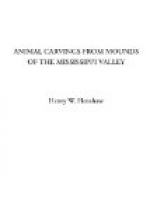In considering the degree of skill exhibited by the mound sculptors in their delineation of the features and characteristics of animals, it is of the utmost importance to note that the carvings of birds and animals which have evoked the most extravagant expressions of praise as to the exactness with which nature has been copied are uniformly those which, owing to the possession of some unusual or salient characteristic, are exceedingly easy of imitation. The stout body and broad flat tail of the beaver, the characteristic physiognomy of the wild cat and panther, so utterly dissimilar to that of other animals, the tufted head and fish-eating habits of the heron, the raptorial bill and claws of the hawk, the rattle of the rattlesnake, are all features which the rudest skill could scarcely fail to portray.
It is by the delineation of these marked and unmistakable features, and not the sculptor’s power to express the subtleties of animal characteristics, that enables the identity of a comparatively small number of the carvings to be established. It is true that the contrary has often been asserted, and that almost everything has been claimed for the carvings, in the way of artistic execution, that would be claimed for the best products of modern skill. Squier and Davis in fact go so far in their admiration (Ancient Monuments, p. 272), as to say that, so far as fidelity is concerned, many of them (i.e., animal carvings) deserve to rank by the side of the best efforts of the artist naturalists in our own day—a statement which is simply preposterous. So far, in point of fact, is this from being true that an examination of the series of animal sculptures cannot fail to convince any one, who is even tolerably well acquainted with our common birds and animals, that it is simply impossible to recognize specific features in the great majority of them. They were either not intended to be copies of particular species, or, if so intended, the artist’s skill was wholly inadequate for his purpose.
Some remarks by Dr. Coues, quoted in an article by E. A. Barber on Mound Pipes in the American Naturalist for April, 1882, are so apropos to the subject that they are here reprinted. The paragraph is in response to a request to identify a bird pipe:
As is so frequently the probable case in such matters, I am inclined to think the sculptor had no particular bird in mind in executing his rude carving. It is not necessary, or indeed, permissible, to suppose that particular species were intended to be represented. Not unfrequently the likeness of some marked bird is so good as to be unmistakable, but the reverse is oftener the case; and in the present instance I can make no more of the carving than you have done, excepting that if any particular species may have been in the carver’s mind, his execution does not suffice for its determination.
The views entertained by Dr. Coues as to the resemblances of the carvings will thus be seen to coincide with those expressed above. Another prominent ornithologist, Mr. Ridgway, has also given verbal expression to precisely similar views.




